In re First Reserve Management, L.P.; First Reserve Corporation, L.L.C.; FR XII Alpha AIV, L.P.; FR XII-A Alpha AIV, L.P.; FR Sawgrass, L.P.; and Sawgrass Holdings, L.P. (No. 22-0227; delivered June 23, 2023) arose from a massive explosion at a petrochemical processing plant in Port Neches on Thanksgiving Eve, 2019. The accident resulted in more than 2,000 lawsuits with 7,000 plaintiffs, whose claims were consolidated in an MDL court. Plaintiffs sued TPC Group, which owned the plant, and later added three co-defendants, including two private-investor groups, that indirectly owned TPC. Plaintiffs sought to hold the investors directly liable for their damages, alleging that in the interest of the bottom line they held up a turnaround at the plant that would have prevented the accident. The investors filed a Rule 91a motion to dismiss, which the MDL court denied. The Beaumont Court of Appeals affirmed. The investors filed a petition for writ of mandamus with SCOTX.
In an opinion by Chief Justice Hecht, SCOTX denied the petition. While the investors’ mandamus petition was pending, TPC filed for bankruptcy protection in Delaware. The bankruptcy court approved a global settlement of the claims of unsecured creditors, including plaintiffs. TPC further released any claims it may have asserted against the investors, which the bankruptcy court ruled included plaintiffs’ veil-piercing and alter ego claims. The settlement thus barred plaintiffs from asserting those claims in litigation, but the bankruptcy court entertained plaintiffs’ negligent undertaking claim. It subsequently rejected the claim and directed plaintiffs to submit a revised pleading complying with the settlement plan, but nevertheless indicated doubts about the investors’ argument that the negligent undertaking claim was really a veil-piercing claim under another name. Both plaintiffs and the investors appealed the bankruptcy court’s order.
SCOTX declined to wade into the investors’ arguments about the veil-piercing and alter ego claims, since the bankruptcy court had enjoined plaintiffs from pursuing them. It further decided to let the MDL court figure out whether plaintiffs’ negligent undertaking claim could be disentangled from those claims, as the bankruptcy court suggested might be done. The question then became whether plaintiffs’ negligent undertaking claim could survive a Rule 91a motion to dismiss. This required the Court to determine whether the investors, who plaintiffs alleged directed the day-to-day operations of TPC, owed a legal duty of reasonable care to plaintiffs. At the same time, as Chief Justice Hecht observed, plaintiffs did not attempt to argue that the directors exercised control over TPC either through indirect ownership or the appointment of the board overseeing TPC. Those are standard corporate structure issues. Whether plaintiffs could state a cause of action, however, depended on specific factual allegations showing that the investors “undertook in other ways to run TPC’s day-to-day operations and, specifically, to delay the turnaround that could have prevented the explosions.”
In order to satisfy the notice-pleading rule, plaintiffs’ allegations have to do more than give notice of their legal theory. In this case, however, they “[made] no allegation that [the investors]—a group of entities that are distinct from Sawgrass Holdings GP—undertook to render services to TPC” and “their negligent-undertaking claim has no basis in law.” Even if the investors delayed the turnaround, as plaintiffs alleged, “an undertaking duty cannot be predicated on an omission, a promise that is not performed or relief on by the injured party, the failure to make an expenditure, or a parent’s supervision of its subsidiary’s financial and budgetary decisions” (citations omitted). Plaintiffs further presented no evidence that the investors “[themselves] decided whether to provide or withhold resources to TPC” or had any “authority… over TPC’s budget and expenses.” In short, Chief Justice Hecht wrote, “[p]laintiffs’ third amended petition makes many legal accusations but no factual allegations to show a cause of action with a basis in law against [the investors] for TPC’s conduct. The MDL court should have granted [the investors’] motion to dismiss.”
Still, the Court declined to issue the writ of mandamus directing the MDL court to take action because, as Chief Justice Hecht stated, “we cannot determine what disruption a directive would have on proceedings that have been stayed during the bankruptcy proceedings and may resume on a different petition.” In other words, until plaintiffs’ replead their case based on the bankruptcy court’s order, there is no point in SCOTX inserting itself in that process at the moment. It is interesting to note, however, that a Rule 91a dismissal carries cost and fee-shifting along with it. If the MDL court should have dismissed plaintiffs’ negligent undertaking claim under Rule 91a, what will become of that?








